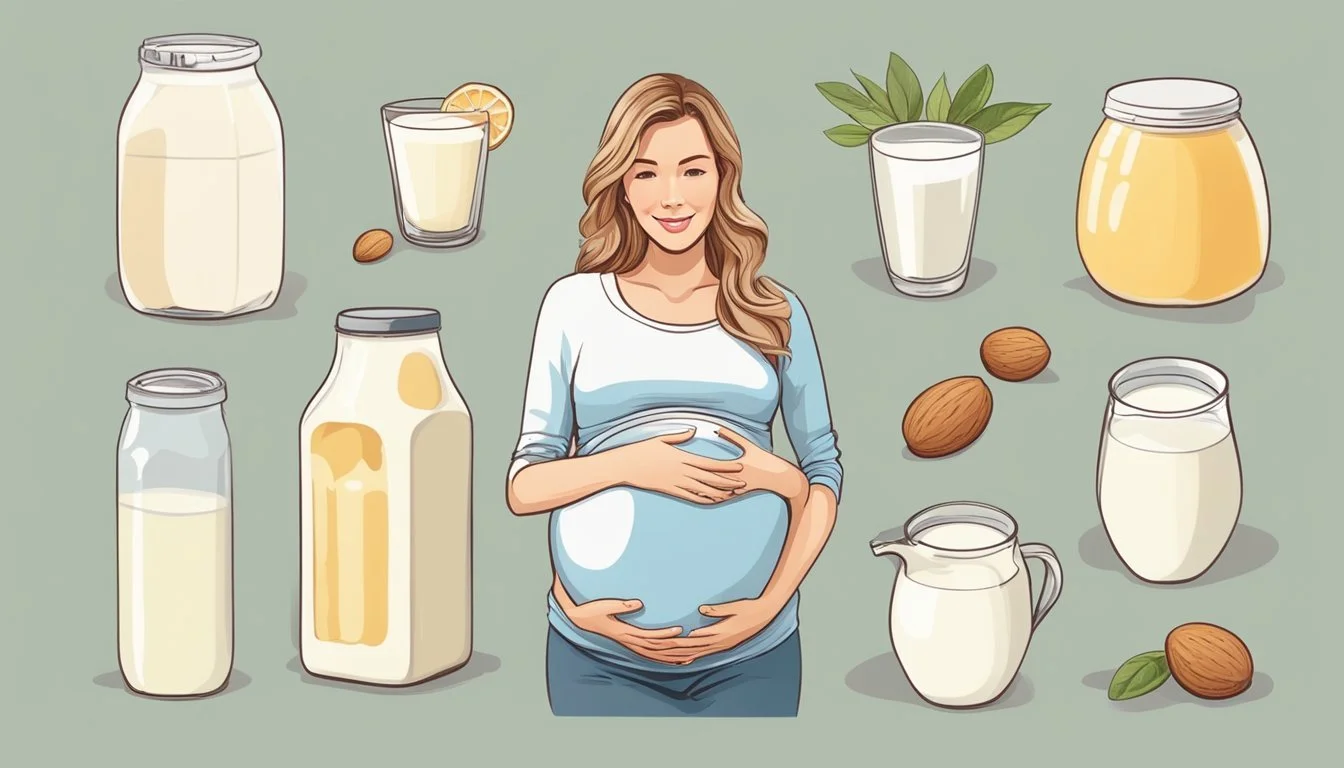Raw Milk and Pregnancy
Risks, Benefits, and Guidelines
Pregnancy is a time when nutrition and food safety are of utmost importance, and the discussion about the consumption of raw milk during this period is multifaceted and critical. Raw milk, unprocessed and unheated, retains its natural enzymes and beneficial bacteria, which some proponents argue contribute to better health. However, the concern for pregnant individuals is the potential presence of harmful pathogens such as Listeria, E. coli, and Salmonella, which can pose significant risks to both the mother and developing fetus.
The debate over raw milk's safety during pregnancy is influenced by the balance between nutritional benefits and health risks. Advocates for raw milk consumption claim that it provides essential nutrients that are beneficial during pregnancy. In contrast, health authorities warn against the consumption of unpasteurized milk due to the dangers associated with bacterial contamination. The risk of contracting illnesses like listeriosis, which can lead to miscarriage or severe illness in newborns, is a grave consideration for pregnant individuals when making dietary choices.
Determining whether to include raw milk in a prenatal diet involves assessing the risks of pathogen exposure against the desire for the perceived benefits of consuming milk in its natural state. As pregnant individuals weigh these considerations, they must have access to comprehensive, accurate information to make informed decisions that prioritize their health and that of their unborn children. The guidance of healthcare providers, in conjunction with research and food safety regulations, plays a pivotal role in navigating these choices.
Raw milk enthusiasts often tout the numerous benefits of incorporating raw milk into a whole foods diet during pregnancy. The raw milk acne connection has been a topic of interest, with some proponents suggesting that the consumption of artisanal cheese raw milk and raw milk ghee can contribute to healthier skin. Additionally, sustainable raw milk farming practices have gained attention for their potential to provide high-quality, nutrient-rich milk that supports the nutritional needs of expectant mothers.
Furthermore, many women believe that including raw milk in their diet can aid in weight management during pregnancy. The natural fats and proteins in raw milk are thought to provide satiety and energy, while supporting the body's nutritional requirements for a healthy pregnancy.
Moreover, the consumption of raw milk is often seen as a way to support local farmers and promote sustainable agricultural practices. Advocates of raw milk emphasize the importance of sourcing milk from trusted, responsible sources to ensure its safety and quality.
Ultimately, while the decision to consume raw milk during pregnancy is a personal one, many women find value in the nutritional benefits and potential positive impacts on their overall well-being.
Understanding Raw Milk
Raw milk is a significant food topic, as it involves considerations of nutrition, health risks, and the differences between its untreated form and pasteurized versions. This section provides a detailed perspective on raw milk's definition, its nutritional attributes, and how it is distinct from pasteurized milk.
Definition and Sources
Raw milk refers to milk that comes directly from cows, goats, or sheep and has not undergone the process of pasteurization. This milk is often consumed for its perceived benefits and is sourced from animals raised on organic, fresh pastures.
Nutritional Profile
Raw milk is often touted as being more nutritious than its pasteurized counterpart. It provides a complex array of nutrients, including calcium, vitamins such as vitamin C and B-vitamins, and a range of enzymes. These elements are considered crucial for overall nutritional balance.
Nutrient Presence in Raw Milk Calcium High Vitamin C Varied B-vitamins Varied Enzymes Natural concentrations
Comparison to Pasteurized Milk
When comparing raw milk to pasteurized milk, the key difference lies in the pasteurization process itself. Pasteurization is the act of heating milk to a specific temperature for a set period to kill harmful bacteria. This process can affect the nutritional content, with some claiming that pasteurized milk lacks certain nutrients found abundantly in raw milk. However, pasteurized milk is widely acknowledged for its safety, as pasteurization eliminates pathogenic bacteria that can cause serious illness.
Health Risks Associated With Raw Milk
Raw milk consumption during pregnancy poses significant health risks due to the potential for contamination with harmful pathogens that can lead to serious infections. Pregnant women, children, and the immunocompromised are particularly at risk.
Potential for Contamination
Raw milk, being unprocessed, is susceptible to contamination at various points from udder to distribution. The milking process, storage, and handling can introduce various bacteria, increasing the risk of foodborne illnesses.
Common Pathogens in Raw Milk
The most concerning bacteria found in raw milk include:
Listeria monocytogenes: Causes listeriosis, especially dangerous for pregnant women and may lead to miscarriage, stillbirth, or neonatal death.
Salmonella: Can result in gastroenteritis, fever, and diarrhea, more severe in young children.
Campylobacter jejuni: Often results in campylobacteriosis, leading to diarrhea, abdominal pain, and fever.
Outbreaks and Disease Incidence
The Centers for Disease Control and Prevention (CDC) reports multiple outbreaks of disease each year attributed to raw milk consumption. Between 2007 and 2012, 148 outbreaks were reported due to raw milk or raw milk products. These outbreaks led to a wide range of illnesses, with the most vulnerable groups facing the highest risk of severe disease outcomes.
Raw Milk Consumption During Pregnancy
When discussing raw milk during pregnancy, it is pivotal to consider official health guidelines, potential risks to fetal health, and suitable dairy alternatives.
Guidelines and Recommendations
The Centers for Disease Control and Prevention (CDC), the Food and Drug Administration (FDA), and the American Academy of Pediatrics all strongly advise against the consumption of raw milk and raw milk products during pregnancy. They cite the presence of harmful bacteria, such as Listeria, Salmonella, and Escherichia coli, which can lead to serious health issues including miscarriage, stillbirth, and neonatal deaths.
Risks to Fetal Health and Development
The consumption of raw milk by pregnant individuals poses a significant risk due to the potential presence of bacteria that can cause infections. Infections from bacteria like Listeria can result in pregnancy complications, leading to adverse outcomes like miscarriage or neonatal death. Additionally, infections can increase the risk of prematurity and low birth weight.
Listeria: A bacteria that can cause miscarriage or illness in newborns.
Salmonella: May lead to severe gastrointestinal illnesses.
Escherichia coli (E. coli): Can cause severe foodborne diseases.
Alternative Dairy Products
To avoid the risks associated with raw milk consumption, pregnant individuals can opt for pasteurized dairy products, which have undergone a heat process to kill harmful bacteria.
Cheese: Pasteurized cheese is a safe alternative. Avoid cheeses like Queso Blanco and Queso Fresco unless they are confirmed to be pasteurized.
Yogurt: Choosing yogurt made from pasteurized milk minimizes risk.
Butter: It is recommended to use butter made from pasteurized cream.
The emphasis on pasteurization ensures that the mother can enjoy the health benefits of dairy while reducing the risk of bacteria-related pregnancy complications.
Regulatory Stance on Raw Milk
The consumption of raw milk, which is milk not subjected to the pasteurization process, is regulated differently across the United States. These rules are designed to manage the risks associated with pathogens that can be transmitted through unpasteurized dairy products.
State Regulations and Laws
In the United States, the legality of selling raw or unpasteurized milk varies by state, with at least 30 states allowing its sale in some form. State laws often regulate the sale of raw milk at farms, through retail, or by consumer-owned herdshare programs. Regulations may include but are not limited to:
Permits or licensing requirements for farmers.
Testing of milk and milk products for pathogens.
Labeling requirements that indicate the milk is not pasteurized.
Table illustrating select state stance on raw milk sales:
State Sales Allowed Restrictions/Comments California Yes Retail sales permitted with labeling Pennsylvania Yes Farm sales regulated with permits Ohio No (with exceptions for herdshare) Herdshares are overseen but not retail sale New York Limited Only farm sales allowed, no retail
Federal Guidelines and Safety Measures
The Food and Drug Administration (FDA) maintains a ban on the interstate sale or distribution of raw milk and milk products for human consumption. This ban reflects concerns about foodborne pathogens such as Listeria, Salmonella, and E. coli, which can cause serious illness. To promote food safety, the FDA endorses the following:
Universal pasteurization of milk intended for consumption.
Educational efforts to inform the public about the risks of raw milk.
Enforcement actions against distributors of raw milk across state lines.
The FDA does not regulate intrastate sales, leaving that authority to individual states. However, they actively participate in guidelines and safety measures consultation to ensure public health protection. Additionally, products such as cheese made from raw milk must adhere to specific aging requirements before they are considered safe for consumption.
Research and Studies on Raw Milk
Research on raw milk, especially in the context of pregnancy, provides insights into its health implications and nutritional benefits. Various studies have been conducted with methodologies ranging from prospective and retrospective cohort studies to cross-sectional studies and systematic reviews.
Available Literature
Literature on the consumption of raw milk during pregnancy can be accessed through databases such as PubMed and Web of Science. These studies tend to be featured in systematic reviews and meta-analyses to ensure a comprehensive synthesis of available research. A PROSPERO registration often precedes such systematic reviews, delineating the review protocol.
Scientific Findings on Health Impact
Scientific findings regarding the health impact of raw milk consumption during pregnancy often emerge from study designs like cross-sectional studies and cohort studies. Such research has revealed a correlation between raw milk intake and foodborne illness outbreaks, drawing a connection to significant health risks for pregnant women and children. These risks include exposure to pathogens like listeria and E. coli, which are especially concerning during pregnancy due to the enhanced susceptibility of expectant mothers and potential risks to fetal health.
Evidence on Nutritional Benefits
On the other hand, some studies highlight potential nutritional benefits of raw milk, such as a higher content of probiotics. These studies may suggest that certain components in raw milk contribute to the nutritional value and could offer health benefits. However, the scientific community typically stresses caution due to the health risks associated with unpasteurized milk. The focus on health benefits is often weighed against the safety concerns, particularly for vulnerable populations such as pregnant women and young children.
Practical Considerations and Alternatives
When considering the consumption of raw milk during pregnancy, it is paramount to weigh the potential benefits against food safety concerns. Pregnant women should consider safe consumption practices and explore dairy alternatives and supplements to meet their nutritional requirements.
Safe Consumption Practices
Raw milk, while praised by some for its potential benefits, carries a risk of containing harmful bacteria that can pose serious health risks to both the pregnant woman and the fetus. Food safety authorities strongly recommend against the consumption of raw milk during pregnancy. Instead, they advise opting for pasteurized milk, which has undergone a heating process to kill bacteria without significantly affecting nutritional content.
For dairy products like soft cheeses (What wine goes well with soft cheeses?) and ice cream, pregnant women should ensure that they are made from pasteurized milk. These products can sometimes be made from raw milk, which increases the risk of bacterial contamination. Food safety practices are crucial during pregnancy; one should follow proper storage guidelines for dairy products and adhere to use-by dates to reduce the risk of foodborne illnesses.
Dairy Alternatives and Supplements
For those who choose not to consume dairy, or have lactose intolerance, dairy alternatives provide a safe and nutritious option. Plant-based milks such as almond, soy, and oat milk are often fortified with calcium and other vitamins to ensure that daily nutritional needs are met. Pregnant women should read labels carefully to choose products that are fortified and have minimal added sugars.
Adequate calcium intake is vital during pregnancy for fetal bone development and to support the mother's lactation needs. If dairy or its alternatives do not meet the calcium requirements, supplements may be considered. It is recommended to consult a healthcare provider before starting any supplements to determine the appropriate dosage and to ensure that the supplements will not interfere with the absorption of other important nutrients.
Conclusion
The discourse on raw milk consumption during pregnancy has consistently circled around its purported nutritional benefits juxtaposed with safety concerns due to potential contamination.
Balancing Benefits and Risks
When a pregnant individual considers the consumption of raw milk, they face a complex decision-making process that entails weighing potential benefits against inherent risks. The benefits of raw milk may include a richer nutritional profile with enzymes and probiotics that some advocates suggest could be favorable for both the mother and baby’s health. However, these benefits are not conclusively supported by robust scientific evidence and should be considered with caution.
On the other hand, the risks associated with raw milk are tangible and scientifically documented. Raw milk can harbor dangerous pathogens such as Listeria monocytogenes, Campylobacter jejuni, Salmonella species, Brucella species, and Escherichia coli O157, all of which pose serious health threats to both the pregnant individual and the fetus. These risks substantiate the stance of multiple health organizations which advise against the consumption of raw or unpasteurized milk during pregnancy.
For pregnant individuals seeking safe dietary choices, the consensus among health professionals is clear: pasteurized milk is the recommended option due to its reduced risk profile. It is essential that trust in these health recommendations is upheld, in order to safeguard the wellbeing of both mother and child. The decision-making process should, therefore, incorporate not only personal preferences but also scientific evidence and expert guidance to ensure that health is not compromised.







